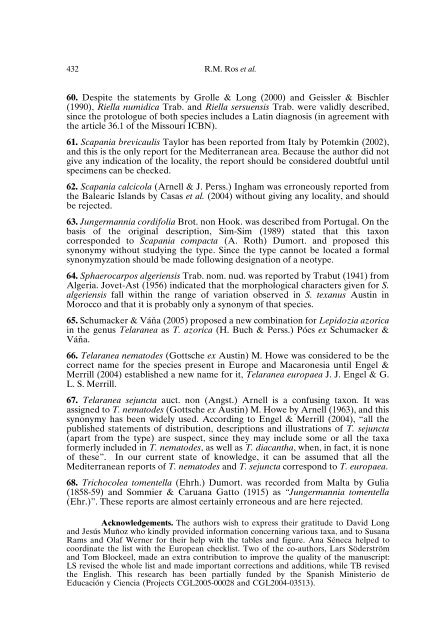Hepatics and Anthocerotes of the Mediterranean, an ... - NTNU
Hepatics and Anthocerotes of the Mediterranean, an ... - NTNU
Hepatics and Anthocerotes of the Mediterranean, an ... - NTNU
You also want an ePaper? Increase the reach of your titles
YUMPU automatically turns print PDFs into web optimized ePapers that Google loves.
432 R.M. Ros et al.60. Despite <strong>the</strong> statements by Grolle & Long (2000) <strong><strong>an</strong>d</strong> Geissler & Bischler(1990), Riella numidica Trab. <strong><strong>an</strong>d</strong> Riella sersuensis Trab. were validly described,since <strong>the</strong> protologue <strong>of</strong> both species includes a Latin diagnosis (in agreement with<strong>the</strong> article 36.1 <strong>of</strong> <strong>the</strong> Missouri ICBN).61. Scap<strong>an</strong>ia brevicaulis Taylor has been reported from Italy by Potemkin (2002),<strong><strong>an</strong>d</strong> this is <strong>the</strong> only report for <strong>the</strong> <strong>Mediterr<strong>an</strong>e<strong>an</strong></strong> area. Because <strong>the</strong> author did notgive <strong>an</strong>y indication <strong>of</strong> <strong>the</strong> locality, <strong>the</strong> report should be considered doubtful untilspecimens c<strong>an</strong> be checked.62. Scap<strong>an</strong>ia calcicola (Arnell & J. Perss.) Ingham was erroneously reported from<strong>the</strong> Balearic Isl<strong><strong>an</strong>d</strong>s by Casas et al. (2004) without giving <strong>an</strong>y locality, <strong><strong>an</strong>d</strong> shouldbe rejected.63. Jungerm<strong>an</strong>nia cordifolia Brot. non Hook. was described from Portugal. On <strong>the</strong>basis <strong>of</strong> <strong>the</strong> original description, Sim-Sim (1989) stated that this taxoncorresponded to Scap<strong>an</strong>ia compacta (A. Roth) Dumort. <strong><strong>an</strong>d</strong> proposed thissynonymy without studying <strong>the</strong> type. Since <strong>the</strong> type c<strong>an</strong>not be located a formalsynonymyzation should be made following designation <strong>of</strong> a neotype.64. Sphaerocarpos algeriensis Trab. nom. nud. was reported by Trabut (1941) fromAlgeria. Jovet-Ast (1956) indicated that <strong>the</strong> morphological characters given for S.algeriensis fall within <strong>the</strong> r<strong>an</strong>ge <strong>of</strong> variation observed in S. tex<strong>an</strong>us Austin inMorocco <strong><strong>an</strong>d</strong> that it is probably only a synonym <strong>of</strong> that species.65. Schumacker & Vá≈ a (2005) proposed a new combination for Lepidozia azoricain <strong>the</strong> genus Telar<strong>an</strong>ea as T. azorica (H. Buch & Perss.) Pócs ex Schumacker &Vá≈ a.66. Telar<strong>an</strong>ea nematodes (Gottsche ex Austin) M. Howe was considered to be <strong>the</strong>correct name for <strong>the</strong> species present in Europe <strong><strong>an</strong>d</strong> Macaronesia until Engel &Merrill (2004) established a new name for it, Telar<strong>an</strong>ea europaea J. J. Engel & G.L. S. Merrill.67. Telar<strong>an</strong>ea sejuncta auct. non (Angst.) Arnell is a confusing taxon. It wasassigned to T. nematodes ( Gottsc he ex Austin) M. Howe by Arnell (1963), <strong><strong>an</strong>d</strong> thissynonymy has been widely used. According to Engel & Merrill (2004), “all <strong>the</strong>published statements <strong>of</strong> distribution, descriptions <strong><strong>an</strong>d</strong> illustrations <strong>of</strong> T. sejuncta(apart from <strong>the</strong> type) are suspect, since <strong>the</strong>y may include some or all <strong>the</strong> taxaformerly included in T. nematodes , as well as T. diac<strong>an</strong>tha , when, in fact, it is none<strong>of</strong> <strong>the</strong>se”. In our current state <strong>of</strong> knowledge, it c<strong>an</strong> be assumed that all <strong>the</strong><strong>Mediterr<strong>an</strong>e<strong>an</strong></strong> reports <strong>of</strong> T. nematodes <strong><strong>an</strong>d</strong> T. sejuncta correspond to T. europaea .68. Trichocolea tomentella (Ehrh.) Dumort. was recorded from Malta by Gulia(1858-59) <strong><strong>an</strong>d</strong> Sommier & Caru<strong>an</strong>a Gatto (1915) as “Jungerm<strong>an</strong>nia tomentella(Ehr.)”. These reports are almost certainly erroneous <strong><strong>an</strong>d</strong> are here rejected.Acknowledgements. The authors wish to express <strong>the</strong>ir gratitude to David Long<strong><strong>an</strong>d</strong> Jesús Muñoz who kindly provided information concerning various taxa, <strong><strong>an</strong>d</strong> to Sus<strong>an</strong>aRams <strong><strong>an</strong>d</strong> Olaf Werner for <strong>the</strong>ir help with <strong>the</strong> tables <strong><strong>an</strong>d</strong> figure. Ana Séneca helped tocoordinate <strong>the</strong> list with <strong>the</strong> Europe<strong>an</strong> checklist. Two <strong>of</strong> <strong>the</strong> co-authors, Lars Söderström<strong><strong>an</strong>d</strong> Tom Blockeel, made <strong>an</strong> extra contribution to improve <strong>the</strong> quality <strong>of</strong> <strong>the</strong> m<strong>an</strong>uscript:LS revised <strong>the</strong> whole list <strong><strong>an</strong>d</strong> made import<strong>an</strong>t corrections <strong><strong>an</strong>d</strong> additions, while TB revised<strong>the</strong> English. This research has been partially funded by <strong>the</strong> Sp<strong>an</strong>ish Ministerio deEducación y Ciencia (Projects CGL2005-00028 <strong><strong>an</strong>d</strong> CGL2004-03513).






